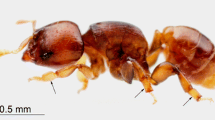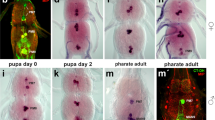Summary
The sternal gland of Kalotermes flavicollis is an epidermal thickening of the fifth abdominal sternite. It secretes a trail pheromone dissolved in a lipid substance. Two main cells types constitute the gland: basal glandular cells and columnar cells-with a brush border beneath the cuticle. We can also recognize two regions in the gland. At the anterior part the glandular cells, full of lipid droplets, are more developed; the cuticle is composed of endocuticle and epicuticle. At the posterior part, the glandular cells contain glycogen; the cuticle is made of mesocuticle and epicuticle.
The glandular cells of the anterior part secrete lipid droplets associated with mitochondria. The secretion passes into the columnar cells and, by way of the smooth reticulum, seems to be discharged by the microvilli; it crosses the cuticle by means of pore-canals perforating the epicuticle. The posterior part is less developed, but the structure of cuticle suggests also a secretory activity at this level. The complexity of the secretion is emphasized.
Résumé
La glande sternale de Kalotermes flavicollis est un épaississement épidermique du cinquième sternite abdominal. Elle sécrète une phéromone de piste dissoute dans un lipide. Deux types cellulaires principaux se reconnaissent: des cellules glandulaires basales et des cellules intercalaires. On peut en outre distinguer deux régions. La partie antérieure où les cellules glandulaires, plus développées, sont emplies de gouttelettes lipidiques, la cuticule y est formée d'endoeuticule et d'épicuticule. A la partie postérieure, les cellules glandulaires contiennent du glycogène, la cuticule est formée de mésocuticule et d'épicuticule.
Les cellules glandulaires de la région antérieure élaborent des globules lipidiques associés aux mitochondries. La sécrétion gagne les cellules intercalaires et, par l'intermédiaire du reticulum endoplasmique, paraît se libérer depuis les microvillosités; elle traverse la cuticule par les canaux poraires qui aboutissent à de fines perforations de l'épicuticule. La partie postérieure est moins différenciée, mais la structure de la cuticule indique également une activité sécrétoire dans cette région. L'accent est mis sur la nature complexe de la sécrétion.
Similar content being viewed by others
Bibliographie
Anderson, W. A., Ellis, R. A.: Ultrastructure of Trypanosoma lewisi: flagellum, microtubules and the kinetoplast. J. Protozool. 12, 483–499 (1965).
Baccetti, B., Mazzi, V., Massimello, G.: Ricerche istochimiche e al microscopio elettronico sui tubi Malpighiani di Dacus oleae Gmel. I. La larva. Z. Zellforsch. 59, 47–70 (1963).
Ballan-Dufrançais, C.: Données cytophysiologiques sur un organe excréteur particulier d'un insecte, Blattella germanica L. (Dictyoptère). Z. Zellforsch. 109, 336–355 (1970).
Clements, A. N., Potter, S. A.: The fine structure of the spermathecae and their ducts in the mosquito Aedes aegypti. J. Insect Physiol. 13, 1825–1836 (1967).
Coenen-Saraber, C. M. A., Ritter, F. J.: Food attractants and a pheromone as trail-following substances for the saintonge termite. Multiplicity of the trail-following substances in L. trabea-infected wood. Ent. Exp. Appl. 12, 611–622 (1969).
Crossley, A. C. S., Waterhouse, D. F.: The ultrastructure of a pheromone-secreting gland in the male scorpion fly Harpobittacus australis (Bittacidae, Mecoptera). Tissue and Cell 1, 273–294 (1969a).
—: The ultrastructure of the osmeterium and the nature of its secretion in Papilio larvae (Lepidoptera). Tissue and Cell 1, 525–554 (1969b).
Eisner, T., Mac Henry, F., Salpeter, M. M.: Defense mechanisms of Arthropods. XV. Morphology of the quinone-producing glands of a tenebrionid beetle (Eleodes longicollis Lee.). J. Morph. 115, 355–399 (1964).
Ernst, K.-D.: Die Feinstruktur von Riechsensillen auf der Antenne des Aaskäfers Necrophorus (Coleoptera). Z. Zellforsch. 94, 72–102 (1969).
Evans, J. J. T.: The integument of the Queensland fruit fly, Dacus tryoni (Frogg.). I. The tergal glands. Z. Zellforsch. 81, 18–33 (1967).
Filshie, B. K.: The resistance of epicuticular components of an insect to extraction with lipid solvents. Tissue and Cell 2, 181–190 (1970).
—, Waterhouse, D. F.: The fine structure of the lateral scent glands of the green vegetable bug Nezara viridula (Hemiptera, Pentatomidae). J. Microscopie 7, 231–244 (1968).
Gabe, M.: Neurosécrétion. Paris: Gauthier-Villars 1967.
Happ, G. M., Strandberg, J. D., Happ, C. M.: The terpene-producing gland of a phasmid insect: cell morphology and histochemistry. J. Morph. 119, 143–160 (1966).
Hummel, H., Karlson, P.: Hexansäure als Bestandteil des Spurpheromons der Termite Zootermopsis nevadensis Hagen. Hoppe-Seylers Z. physiol. Chem. 349, 725–727 (1968).
Idelman, S.: Ultrastructure of the mammalian adrenal cortex. Int. Rev. Cytol. 27, 181–281 (1970).
Jacob, J., Jurand, A.: Electron microscope studies on salivary gland. V. The cytoplasm of Smittia parthenogenetica (Chironomidae). J. Insect Physiol. 11, 1337–1343 (1965).
Karlson, P., Lüscher, M., Hummel, H.: Extraktion und biologische Auswertung des Spurpheromons der Termite Zootermopsis nevadensis. J. Insect Physiol. 14, 1763–1771 (1968).
Kloetzel, J. A., Laufer, H.: A fine structural analysis of larval salivary gland function in Chironomus thummi (Diptera). J. Ultrastruct. Res. 29, 15–36 (1969).
Lison, L.: Histochimie et cytochimie animales. Paris: Gauthier-Villars 1960.
Locke, M.: The cuticle and wax secretion in insect cuticle. Quart. J. micr. Soc. 101, 333–338 (1960).
—: Pore canals and related structures in insect cuticle. J. biophys. biochem. Cytol. 10, 589–618 (1961).
—: The structure of an epidermal cell during the development of the protein epicuticle and the uptake of molting fluid in an insect. J. Morph. 127, 7–39 (1969).
Lüscher, M., Muller, B.: Ein spurbildendes Sekret bei Termiten. Naturwissenschaften 47, 503 (1960).
Mac Gregor, H. C., Mackie, J. B.: Fine structure of the cytoplasm in salivary glands of Simulium. J. Cell Sci. 2, 137–144 (1967).
Marinozzi, V.: Silver impregnation of ultrathin sections for electron microscopy. J. biophys. biochem. Cytol. 9, 121–133 (1961).
Martoja, R., Martoja-Pierson, M.: Initiation aux techniques de l'histologie animale. Paris: Masson & Cie. 1967.
Matsumura, F., Coppel, H. C., Tai, A.: Isolation and identification of termite trail-following pheromone. Nature (Lond.) 219, 963–964 (1968).
Mercer, E. H., Brunet, P. C. J.: The electron microscopy of the left colleterial gland of the cockroach. J. biophys. biochem. Cytol. 5, 257–262 (1959).
Mertins, J. W., Coppel, H. C., Matsumura, F.: Sternal gland in Coptotermes formosanus (Isoptera: Rhinotermitidae). Ann. Ent. Soc. Amer. 64, 478–480 (1971).
Moore, B. P.: Isolation of the scent-trail of an Australian termite. Nature (Lond.) 211, 746–747 (1966).
—: Biochemical studies in termites. In: K. Krishma, and F. Weesner, Biology of termites, vol. 1, p. 407–432. New York and London: Academic Press 1969.
Mosconi-Bernardini, P., Vecchi, M. L.: Osservazioni istologiche e fluoromicroscopiche sulla ghiandola sternale di Reticulitermes lucifugus (Rhinotermitidae). Symp. Genet. Biol. Ital. 13, 169–177 (1964).
Noirot, Ch.: Glands and secretions. In: K. Krishna, and F. Weesner, Biology of termites, vol. 1, p. 89–123. New York and London: Academic Press 1969.
—, Noirot-Timothée, C.: La glande sternale dans l'évolution des termites. Insectes Sociaux 12, 265–272 (1965a).
—: Ultrastructure de la glande sternale chez le termite Calotermes flavicollis. Proc. XII. Int. Congr. Ent., London, sect. 2, p. 129 (1965b).
—: Organisation de la glande sternale chez Calotermes flavicollis F. (Insecta, Isoptera). Etude au microscope électronique. C. R. Acad. Sci. (Paris) 260, 6202–6204 (1965c).
—: La cuticule proctodéale des insectes. I. Ultrastructure comparée. Z. Zellforsch. 101, 477–509 (1969).
Oschman, J. L., Berridge, J. M.: Structural and functionnal aspects of salivary fluid secretion in Calliphora. Tissue and Cell 2, 281–310 (1970).
Pearse, A. G. E.: Histochemistry, theoretical and applied. London: J. et A. Churchill 1960.
Phillips, D. M., Swift, H.: Cytoplasmic fine structure of Sciara salivary glands. I. Secretion. J. Cell Biol. 27, 395–409 (1965).
Quennedey, A.: Les glandes de Gilson des larves de Phryganea varia Fab. (Insecta, Trichoptera). Etude histochimique et ultrastructurale. J. Microscopie 8, 479–496 (1969a).
—: Innervation de type neurosécréteur dans la glande sternale de Kalotermes flavicollis (Isoptera). Etude ultrastructurale. J. Insect Physiol. 15, 1807–1814 (1969b).
—: Les glandes exocrines des termites. II. Organisation de la glande sternale des Rhinotermitidae. Etude ultrastructurale préliminaire. C. R. Acad. Sci. (Paris) 273, 376–379 1971).
—, Noirot, Ch.: Estérase cuticulaire dans la glande sternale de Calotermes flavicollis F. (Isoptera, Termitidae). Etude histochimique. C. R. Acad. Sci. (Paris) 266, 2456–2458 (1968).
Satir, P., Stuart, A. M.: A new apical microtubule-associated organelle in the sternal gland of Zootermopsis nevadensis (Hagen), Isoptera. J. Cell Biol. 24, 277–283 (1965).
Smythe, R. V., Coppel, H. C.: A preliminary study of the sternal gland of Reticulitermes flavipes (Isoptera: Rhinotermitidae). Ann. Ent. Soc. Amer. 59, 1008–1010 (1966).
Stein, G.: Über den Feinbau der Mandibeldrüse von Hummelmännchen. Z. Zellforsch. 57, 719–736 (1962).
—: Über den Feinbau der Duftdrüsen von Feuerwanzen (Pyrrhocoris apterus L., Geocorisae). Die 2 larvale Abdominaldrüse. Z. Zellforsch. 79, 49–63 (1967).
—: Über den Feinbau der Duftdrüsen von Heteropteren. Die hintere larvale Abdominaldrüse der Baumwollwanze Dysdercus intermedius Dist. (Insecta, Heteroptera). Z. Morph. Tiere 65, 374–391 (1969).
Steinbrecht, R. A.: Feinstruktur und Histochemie der Sexualduftdrüse des Seidenspinners Bombyx mori L. Z. Zellforsch. 64, 227–261 (1964).
Stuart, A. M.: Mechanism of trail laying in two species of termites. Nature (Lond.) 189, 419 (1961).
—: Origin of the trail in the termite Nasutitermes corniger H. and Zootermopsis nevadensis H. Physiol. Zool. 36, 69–84 (1963).
—: The structure and function of the sternal gland in Zootermopsis nevadensis (Isoptera). Proc. Zool. Soc. Lond. 143, 43–52 (1964).
—: Social behavior and communication. In: K. Krishna, and F. Weesner, Biology of termites, vol. 1, p. 193–232. New York and London: Academic Press 1969.
—, Satir, P.: Morphological and functionnal aspects of an insect epidermal gland. J. Cell Biol. 36, 527–549 (1968).
Thiery, J. P.: Mise en évidence des polysaccharides sur coupes fines en microscopie électronique. J. Microscopie 6, 987–1018 (1967).
Thomsen, E., Thomsen, M.: Fine structure of the corpus allatum of the female blowfly Calliphora erythrocephala. Z. Zellforsch. 110, 40–60 (1970).
Voigt, W. H.: Zur funktionellen Morphologie der Fibroin- und Sericin-Sekretion der Seidendrüse von Bombyx mori L. I. Der proximale Abschnitt der Seidendrüse. Z. Zellforsch. 66, 548–570 (1965).
Waku, Y., Sumimoto, K.: Ultrastructure and secretory mechanism of the alluring gland cell in the silkworm, Bombyx mori L. (Lepidoptera: Bombycidae). Appl. Ent. Zool. 4, 135–146 (1969).
Wigglesworth, V. B., Salpeter, M. M.: Histology of the Malpighian tubules in Rhodnius prolixus Stahl (Hemiptera). J. Insect Physiol. 8, 299–307 (1962).
Wright, K. A.: The anatomy of salivary glands of Anopheles stephensi L. Canad. J. Zool. 47, 579–587 (1969).
Author information
Authors and Affiliations
Additional information
Nous exprimons notre gratitude au Professeur Ch. Noirot qui a mis à notre disposition ses résultats personnels et qui a suivi avec bienveillance la réalisation de ce travail.
Rights and permissions
About this article
Cite this article
Quennedey, A. Les glandes exocrines des termites. Z. Zellforsch. 121, 27–47 (1971). https://doi.org/10.1007/BF00330915
Received:
Issue Date:
DOI: https://doi.org/10.1007/BF00330915




